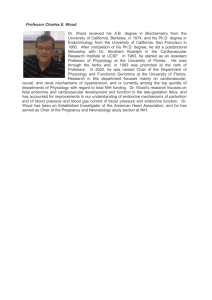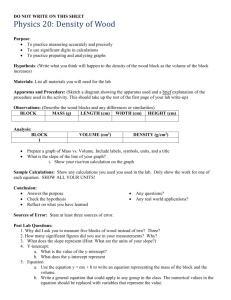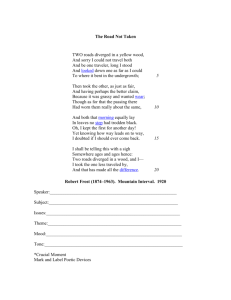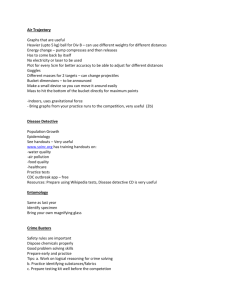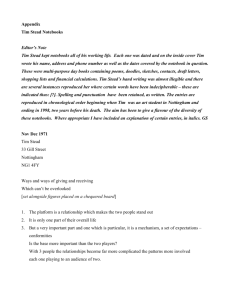2015 DA Week 8 Notes Concepts of “UNIT”. What makes one unit
advertisement
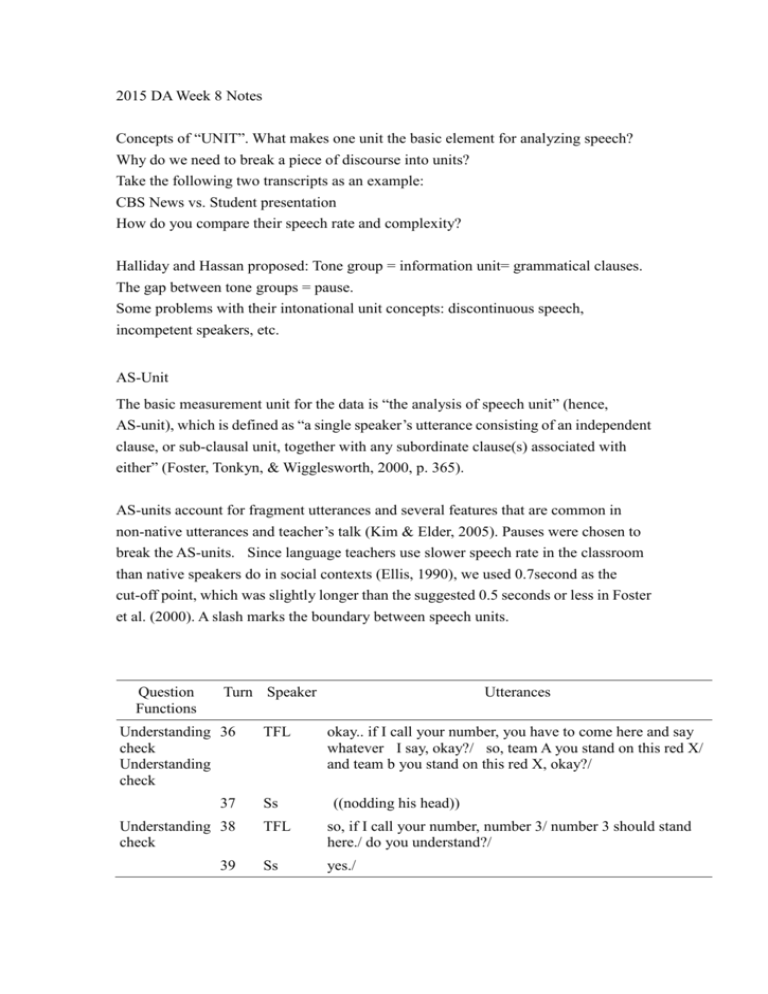
2015 DA Week 8 Notes Concepts of “UNIT”. What makes one unit the basic element for analyzing speech? Why do we need to break a piece of discourse into units? Take the following two transcripts as an example: CBS News vs. Student presentation How do you compare their speech rate and complexity? Halliday and Hassan proposed: Tone group = information unit= grammatical clauses. The gap between tone groups = pause. Some problems with their intonational unit concepts: discontinuous speech, incompetent speakers, etc. AS-Unit The basic measurement unit for the data is “the analysis of speech unit” (hence, AS-unit), which is defined as “a single speaker’s utterance consisting of an independent clause, or sub-clausal unit, together with any subordinate clause(s) associated with either” (Foster, Tonkyn, & Wigglesworth, 2000, p. 365). AS-units account for fragment utterances and several features that are common in non-native utterances and teacher’s talk (Kim & Elder, 2005). Pauses were chosen to break the AS-units. Since language teachers use slower speech rate in the classroom than native speakers do in social contexts (Ellis, 1990), we used 0.7second as the cut-off point, which was slightly longer than the suggested 0.5 seconds or less in Foster et al. (2000). A slash marks the boundary between speech units. Question Functions Turn Speaker Understanding 36 check Understanding check 37 Understanding 38 check 39 TFL Ss Utterances okay.. if I call your number, you have to come here and say whatever I say, okay?/ so, team A you stand on this red X/ and team b you stand on this red X, okay?/ ((nodding his head)) TFL so, if I call your number, number 3/ number 3 should stand here./ do you understand?/ Ss yes./ Exercise 1: Listen to the following TED talk and define the AS units according to the pauses used by the speaker. http://www.ted.com/talks/derek_sivers_how_to_start_a_movement.html After the units are defined, basic analyses can be performed: For example, Average unit length (word/unit) Average speed (unit/minute; word/minute; syllable/second) Discussion 1: How do we compare discourse data of different lengths? Conversational structure The syntactic structure of conversation is less complex because it is constrained by the short memory span of conversation participants. However, conversation is governed by “conversational principles” and “Turn taking” rules. Turn taking When can one speak in a conversation? Transition Relevance Places (Schegloff & Jefferson, 1974) 1. The current speaker (S) “selects” the next speaker (N). 2. If S does not select, any participant can self-select. 3. If no speaker self-selects, S may (or have to?) continue. The next turn is also governed by the requirement enforced by the principle of “the Adjacency Pair”. Greeting greeting. Elicitation verbal reply Command react Complaint Sympathy Request Offer of help Compliment accept/refuse Criticize excuse Provide information acknowledge Trouble telling advise Apology accept In a conversation with 2 participants, A poses the first part in a pair, and B must supply with the second part in that pair. Discussion 2: Give a few examples of adjacency pair. What if one does not follow the principle? Compare: A: Can you do me a favor? B: Yes (falling tone) A: Can you do me a favor? B: Yes (Rising tone) Insertion sequence 1. 1A: What time is it? elicitation 2B: Don't you have a watch? elicitation 3A: It stopped. verbal reply 4 B: Oh..it's four-thirty. verbal reply Cooperative Principle (Grice, 1975) (Power, p. 169) One must make one's contribution as required to the conversation. To do this, conversational participants must cooperate with each other in terms of manner, quality, quantity, and relation. All conversations are built under a presupposition that the participants follow this principle. The maxim of relevance: Be relevant! The maxim of manner: Be brief and orderly! The maxim of quality: Be true! The maxim of quantity: Not too much and not too little! Discussion 3. Give an example to each of these maxims from your real life experience. Speech Act Theory (Austin, 1964; Searle, 1969): The use of words to perform an act. 2. A: (Entering a room) It is cold here. B: (Turn off the air conditioner.) In form, “It's cold here” is a statement, but in function, it is a direction. reaction as the next turn. It requires a A: I announce you Husband and Wife. B & C: Discussion 4: Give some examples of using words to perform actions in real-life. Interaction model in the subject-matter classroom (Sinclair and Coulthard, 1975) The nature of classroom interaction vs. natural interaction: There is usually a follow-up move after an adjacency pair in natural talks. Move Exchange 1 Exchange 2 Exchange 3 3. A: What time is it? B: Four-thirty. A: Thanks. 4. Teacher: What time is it? Pupil: It's four-thirty. Teacher: Good. In the classroom, T asks, Ps answer, and T comments. (TPT sequence). The teacher's questions in the classroom are mostly pseudo, meaning not being asked for eliciting unknown information. This is largely due to the unequal knowledge/ability/competence status between the T and the Ps. 5. (Data from Sinclair and Coulthard, 1975) (T=teacher, P= any pupil who speaks) 1. 2. 3. 4. 5. 6. T: Now then…I’ve got some things here, too. Hands up. What’s that, what is it? Ps: Saw. T: It’s a saw, yes this is a saw. What do we do with a saw? Ps: Cut wood. T: Yes. You’re shouting out though. What do we do with a saw? Marvelette. Marvelette : Cut wood. 7. T: We cut wood. And, erm, what do we do with a hacksaw, this hacksaw? 8. Ps: Cut trees. 9. T: Do we cut trees with this? 10. Ps: No. No. 11. Ts: Hands up. What do we do with this? 12. P: Cut wood. 13. T: Do we cut wood with this? 14. Ps: No. 15. T: What do we do with that then? 16. Ps: Cut wood. 17. T: We cut wood with that. What do we do with that? 18. Cleveland: Sir. 19. T: Cleveland. 20. Cleveland: Metal. 21. T: We cut metal. Yes we cut metal. And, er, I’ve got this here. What’s that? Trevor. 22. Trevor.: An axe. 23. T: It’s an axe yes. What do I cut with the axe? 24. Ps: Wood, wood. 25. T: Yes I cut wood with the axe. Right…Now then, I’ve got some more things here…(etc.) A basic unit of teacher-student interaction: 6. (/ = T/P/T //=TPT//TPT//TPT) 1. T: Now then… I’ve got some things here, too. Hands up. What’s that, what is it?/ 2. P: Saw./ 3. T: It’s a saw, yes this is a saw. // What do we do with a saw? / 4. P: Cut wood. / 5. T: Yes. You’re shouting out though. // What do we do with a saw? Marvelette./ 6. P: Cut wood./ 7. T: We cut wood.// And, erm, what do we do with …etc. IRF Structure: The function of TPT sequence = Teacher Initiates-Pupil Response-Teacher gives Feedback The structure of classroom interaction can be analyzed in a hierarchy Lesson Transaction Exchange Move Act (See Chapter 1 of Advances in Spoken Discourse Analysis) Act: 21 Speech acts Move: Opening, Answering, Follow-up, Framing, Focus Exchange: Boundary (Frame, Focus), Teaching (Initiation, Response, Feedback) Transaction: Relevant topics under the same classroom function (i.e., giving assignment, teaching vocabulary, testing the students, etc.) Lesson: one class period Assignment: Use Sinclair and Coulthad's model to analyze the following natural talk between two colleagues (Josef and Chris) at a university (Data from McCarthy, 1991). Who controls the conversation topic? Justify your claim from your analysis. (Jozef (J) is a visiting scholar from Hungary at an English department in a British university. He has established a fairly informal and relaxed relationship with Chris (C), a lecturer in the department. He pops into Chris’s room on morning.) 1. C: Hello Jozef. 2. J: Hello Chris…could you do me a great favour. 3. C: Yeah. 4. J: I’m going to book four cinema tickets on the phone and they need a credit care number…could you give me your credit card number…they only accept payment by credit care over the phone. 5. C: Ah. 6. J: I telephoned there and they said they wouldn’t do any reservations 7. C: [ without a card. 8. J: Yes and I could pay you back in cash. 9. C: Yes…sure…no problem at all. 10. J: Yes. 11. C: Mm…I’ve got this one, which is an Access card. 12. J: And I just tell them your number. 13. C: [You tell them my number…this one here. 14. J: And they tell me how much. 15. C: That’s right…that’s all…that’s my name there and that number. 16. J: Yes…and I can settle it. 17. C: Yes and bring it back when you’re done. 18. J: Yeah…I’ll just telephone then. 19. C: Right…okay. 20. J: Thanks Chris. 21. C: Cheers. (Jozef leaves the room.)



